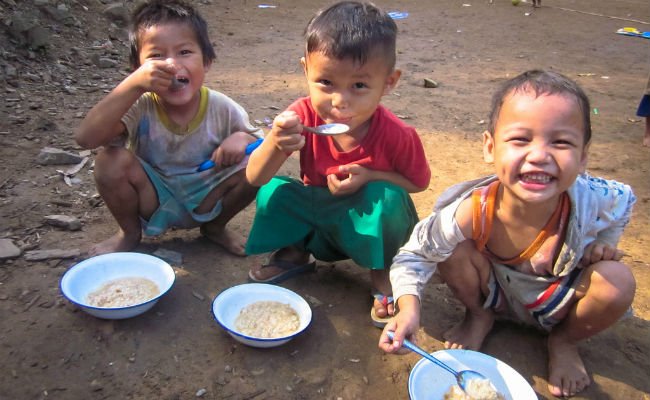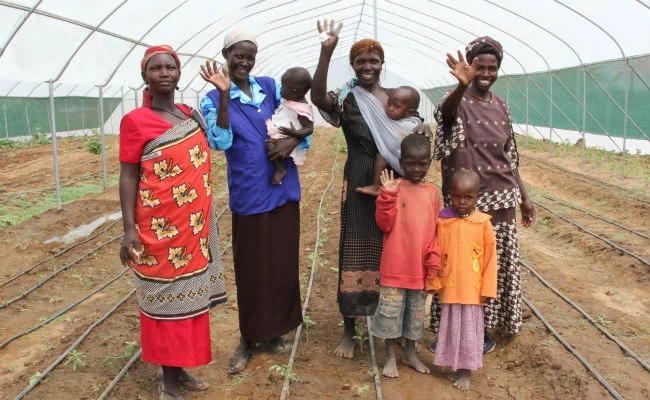I’m what my mom calls a “grazer.” Basically, I like to snack...constantly... otherwise I feel tired, distracted, grumpy, and my stomach starts making loud, embarrassing noises.
All of us know how crappy it is to feel hungry. But if a missed midday yogurt is enough to throw me off, what of the 795 million people suffering from hunger worldwide? That’s 1 in 9 of the global population.
And this is more than a grumbling tummy hunger. This is hunger that results in malnutrition and preventable deaths, hunger that affects the physical development of children, that endangers pregnant women and babies, that negatively impacts the quality of children’s education.
This is the kind of hunger that makes world hunger the single biggest risk to global health.
Global Goal 2 aims to end that. It wants to end hunger and malnutrition by 2030, and ensure access to safe, nutritious and sufficient food for people worldwide. This goes double for people already living in poverty, or in vulnerable situations (like infants).
In order to make this happen, Global Goal 2 also addresses food production. Goal 2 includes increasing investment in agricultural research and development, ensuring sustainable food production, and improving agricultural trade and food markets.
Basically, Global Goal 2 is about making sure the world has enough delicious and nutritious food to eat, and that everyone gets a healthy serving.

So, how plausible is Global Goal 2?
The short of it: Very plausible.
The world has already done a lot to combat hunger, with impressive results. Since 1990 the number of people suffering from hunger has dropped by 216 million people and the portion of undernourished people has gone down from 23.6% to 14.3%.
72 countries have already achieved the Millennium Development target of reducing the proportion of chronically undernourished people by 50%.
And all of this progress happened as the world population grew by nearly 2 billion people since 1990, making it all the more impressive. And there is no reason why we can’t continue this promising trend.
The good news: We already have enough food to feed everyone!
The bad news: Way too much of this food goes to waste.
This is the imbalance we have to fix. According to a recent report, about one-third of the food produced worldwide, the equivalent of US$1 trillion, gets lost or wasted in food production/consumption systems. That’s the same as about 1 in 3 calories never getting eaten. It’s pretty infuriating.
But at least we know we have the supply. Technically, the world has the capacity to produce food for 2 billion more people than even exist today. So it’s possible to more effectively spread access to food.
If you want to feel optimistic about ending world hunger, just check out this Global Voices video:
What countries are leading the way and how are they doing it?
Reduction in world hunger has been happening across the board. From the Zero Hunger program in Brazil that turned the country from one of the world’s largest food importers to one of world’s largest food exporters, to the government in Cape Verde taking full ownership of the country’s in-school meal program, policies and actions worldwide have already helped reduce world hunger.
France even made it illegal for grocery stores to throw out unsold food! Now instead of perfectly good produce and products going to waste, they are donated to charities or turned into animal feed.
But beyond the smaller country-wide programs there are more sweeping global strategies that can work. A few highlights:
Improving agricultural productivity: Ethiopia used to be plagued by high levels of malnourishment and a devastating famine. Now undernourishment is down over 30%. This happened through very simple and tangible agriculturalimprovements, like the use of better fertilizers and herbicides. When small or family farmers become more productive it leads to major gains. In fact, NGOs and governments agree that supporting small farmers is the world’s best chance for future food security.

Nutrition education: Another lesson from Ethiopia. The country implemented a community-based nutrition program that reaches over 1 million children and successfully improved feeding and nutritional habits, resulting in lower rates of physical stunting in children. When people are aware of good feeding techniques, and ensure pregnant women receive the right nutrients, it addresses the problem of hunger from infancy.
New technology: Science has the potential to change the game. If crops could be genetically modified to better withstand natural disasters, or if farmers were given technology for measuring soil conditions, weather patterns, crop management and other purposes, there would be more food for those who need it. These ideas, however, are still new and relatively controversial. Other new technology is less controversial, like these food vouchers that are sent to Iraqi refugees via their mobile phone! It’s simple, efficient, and satisfies both customers and vendors.
Empowering women: Over 40% of the world’s agricultural labor force is comprised of women, but because of various social and economic barriers they are not as productive as they could be. Women operate smaller plots of land, own fewer animals, and don’t have access to adequate resources. If the gender gap was closed, agricultural productivity would go up 2.5-4% in developing countries. Women are also more likely to spend household income on food, so the more money women control, the more likely that money will go to fighting world hunger. All said, it is estimated that if female farmers were on equal footing with their male counterparts, world hunger would be reduced by 17%.

Ending poverty: The leading cause of world hunger is poverty, and so economic growth is a key to ending hunger. It’s simple in theory--more money and trade means the world’s food supply can reach more mouths--but difficult to implement. Countries like China have made strides, where it is estimated that due to economic growth there will be no more hunger by 2020. Of course this begs the question...well, how do you end poverty….but more on that in our next Global Goal.
What can you do to help?
A LOT. The stories of individuals making a difference are all around us. There is the town in Spain that created a “solidarity fridge,” which allowed people to donate their leftovers to a fridge literally located on the sidewalk. There is the woman in the US who created a pay-what-you-can cafe, where clients can either volunteer for their food, pay whatever they can afford, or pay more than the suggested price in order to fund someone else’s meal. There are the people who work at soup kitchens, hold food drives, or help deliver meals.

So get involved! There are countless ways to donate your effort, time, food or money. A few ideas to get you started:
1. Download Feedingforward: It’s an app that allows businesses to donate their excess food with on-demand pickup. If you work anywhere that involves food (or even a business that gets catering), or know someone that does, tell them about the app.
2. Host a Meal Packaging Event: Organizations like Stop Hunger Now allow volunteers to package meals worldwide. It provides a local approach to ending world hunger and needed relief during regional crises or national disasters.
3. Donate the next time you shop: A lot of grocery store chains offer options to donate canned goods at their location or to donate a small amount of money ($1-10) dedicated to ending world hunger at check-out. See if your supermarket does it, and if it doesn’t, ask it to!
4. Reduce your foodprint: A campaign called Eat.Think.Save can turn us all into agents of change! It’s about small things, like bringing home leftovers from meals out, only cooking as much as you really think you’re going to eat, or starting a compost bin in your home. With the amount of food that goes to waste in the world (see above) every little bit counts.
As is the case with every complicated, seemingly-intractable global issue, the first step is awareness. The more you know about world hunger, and the more you spread the word, the more likely Global Goal 2 will succeed.
So go to TAKE ACTION NOW to sign a petition telling the G7 to make bold financial commitments to lift 500 million people out of hunger.